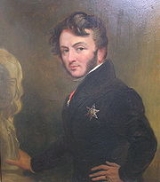
George Hayter
Encyclopedia
Sir George Hayter was a notable English
painter
, specialising in portrait
s and large works involving in some cases several hundred individual portraits. Queen Victoria
appreciated his merits and appointed Hayter her Principal Painter in Ordinary
and also awarded him a Knighthood 1841.
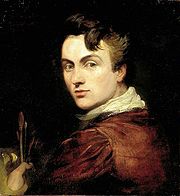 Hayter was the son of Charles Hayter
Hayter was the son of Charles Hayter
(1761–1835), a miniature painter and popular drawing-master and teacher of perspective
who was appointed Professor of Perspective and Drawing to Princess Charlotte and published a well-known introduction to perspective and other works.
Initially tutored by his father, he went to the Royal Academy Schools
early in 1808, but in the same year, after a disagreement about his art studies, ran away to sea as a Midshipman
in the Royal Navy. His father secured his release, and they came to an agreement that Hayter should assist him while pursuing his own studies.
In 1809 he secretly married Sarah Milton, a lodger at his father's house (he was 15 or 16, she 28), the arrangement remaining secret until around 1811. Together they had three children Georgiana, Leopold and Henry.
At the Royal Academy Schools he studied under Fuseli
, and in 1815 was appointed Painter of Miniatures and Portraits by Princess Charlotte
. Hayter was awarded the British Institution
’s premium for history painting for the Prophet Ezra (1815; Downton Castle), purchased by Richard Payne Knight
.
Around 1816 his wife left him, for reasons which are not apparent. He subsequently began a relationship with Louisa Cauty, daughter of Sir William Cauty, with whom he lived openly for the next decade and who bore him two children, Angelo and Louisa (despite not having sought a divorce from his first wife).
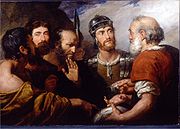 Encouraged by his patron, John Russell, 6th Duke of Bedford
Encouraged by his patron, John Russell, 6th Duke of Bedford
, he travelled to Italy to study in 1816. There he met Canova, whose studio he attended while painting his portrait, where he absorbed Canova’s classical style. He is also believed to have learned sculpture from Canova at this time. Canova was Perpetual Principal of the Accademia di San Luca (Rome's premier artistic institution) and doubtless put Hayter forward for honorary membership on the strength of his painting ‘The Tribute Money’ which was very favourably received in Rome. Hayter thereby became the Academy's youngest ever member.
, Hayter showed a pomposity that irritated his fellow artists, but he mixed freely with many aristocratic families. His unconventional domestic life (separated from his wife, yet living with his mistress) set him apart from official Academy circles: he was never elected to the Royal Academy.
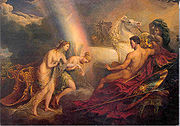 Hayter was most productive and innovative during the 1820s. George Agar-Ellis (later Lord Dover) commissioned the Trial of Queen Caroline
Hayter was most productive and innovative during the 1820s. George Agar-Ellis (later Lord Dover) commissioned the Trial of Queen Caroline
in the House of Lords in 1820 (exh. Cauty’s Great Rooms, 80-82 Pall Mall, 1823; London, National Portrait Gallery); painted on a large scale (2.33×2.66 m), Hayter’s first (and most successful) contemporary history painting revealed a taste for high drama effectively realised. In the Trial of William, Lord Russell
, in the Old Bailey in 1683 (1825; Woburn Abbey) Hayter celebrated John Russell’s ancestry, in a work reminiscent of fashionable tableaux vivants of the country-house set.
(exhibited British Institution 1829), demonstrated Hayter’s assimilation of the style and exotic subject-matter of contemporary French Romantic art.
In 1827 his mistress, Louisa Cauty, died after poisoning herself with arsenic. Although it was apparently an accident, in a bid for attention, it was widely assumed that he had driven her to suicide, and he was forced by the scandal to move from Florence to Rome.
By late 1828 he was in Paris, where his portraits of English society members (some exhibited at the Salon in 1831) were stylistically akin to the work of recent French portrait painters such as François Gérard
.
 In 1831 Hayter returned to England. His grandiose plan to paint the first sitting after the passage of the Reform Bill
In 1831 Hayter returned to England. His grandiose plan to paint the first sitting after the passage of the Reform Bill
resulted in his painting 'Moving the Address to the Crown on the Opening of the First Reformed Parliament in the Old House of Commons, 5 February 1833' (1833–43; London, N.P.G.), for which he executed nearly 400 portrait studies in oil. Hayter was an ardent supporter of the reform movement and this painting was not commissioned but to all intents and purposes a labour of love. It occupied him for ten years with no guarantee of financial reward. This is one of the last images executed of the interior of the old House of Commons before its destruction in the fire of 1834. The painting was finally purchased by the government for the nation in 1854, 20 years after it was started.
Having painted the young Princess Victoria (1832–3; destr.; oil sketch, Brit. Royal Col.), Hayter was not a surprising choice as the new Queen’s 'Portrait and Historical Painter'. But on the death of Sir David Wilkie
in 1841 Hayter's appointment as Principal Painter in Ordinary
to the Queen caused some annoyance at the Royal Academy as this appointment had historically been the preserve of the President, then Sir Martin Archer Shee
. In 1842 Hayter was knighted. He painted several royal ceremonies including Queen Victoria’s coronation of 1837 and marriage of 1840 and also the Christening of the Prince of Wales of 1843 (all Brit. Royal Col.). He also painted several royal portraits including his most well known work the State Portrait of the new Queen Victoria. Several versions of this portrait were done, with the assistance of the artist's son Angelo, to be sent as diplomatic gifts. Hayter's active period at court was short-lived however, because Albert preferred German painters such as F. X. Winterhalter.
Several significant examples of Hayter's works from this period remain a part of the Royal Collection
, and both the State Portrait and Wedding painting are among those displayed to the public at Buckingham Palace
. There is also a full scale version of the State Portrait in the National Portrait Gallery and smaller copy at Holyrood House.
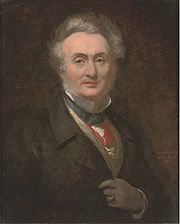 By the mid-1840s Hayter’s portrait style was considered old-fashioned. He adjusted his type of history painting to suit the more literal taste of the early Victorian era (e.g. Wellington Viewing Napoleon’s Effigy at Madame Tussaud’s; destr. 1925; engraving, 1854). Hayter also painted several large religious paintings including two depicting important Reformist events, 'Bishop Latimer Preaching at Paul's Cross' and 'The Martyrdom of Bishops Ridley and Latimer' (exh. 1855), both of which were gifted to the Art Museum, Princeton University, USA in 1984. He also produced fluent landscape watercolours (many of Italian views), etchings (he published a volume in 1833), decorative designs and sculpture. The contents of Hayter’s studio were auctioned at Christie’s, London, on 19 April 1871.
By the mid-1840s Hayter’s portrait style was considered old-fashioned. He adjusted his type of history painting to suit the more literal taste of the early Victorian era (e.g. Wellington Viewing Napoleon’s Effigy at Madame Tussaud’s; destr. 1925; engraving, 1854). Hayter also painted several large religious paintings including two depicting important Reformist events, 'Bishop Latimer Preaching at Paul's Cross' and 'The Martyrdom of Bishops Ridley and Latimer' (exh. 1855), both of which were gifted to the Art Museum, Princeton University, USA in 1984. He also produced fluent landscape watercolours (many of Italian views), etchings (he published a volume in 1833), decorative designs and sculpture. The contents of Hayter’s studio were auctioned at Christie’s, London, on 19 April 1871.
His younger brother, John
(1800–95), was also an artist, known chiefly as a portrait draughtsman in chalks and crayons and his younger sister Anne worked as a miniaturist. Some sources say that the influential printmaker
Stanley William Hayter
was a direct descendant from John Hayter
, although others say the ancestor was Sir George Hayter himself. However the family tree of John and George Hayter published in Crisps Visitations shows no possible link to SW Hayter. What is known for certain is that the French painter and writer, Jean René Bazaine
was a great great grandson of George Hayter, through his eldest daughter Georgiana Elizabeth, who married Pierre-Dominique Bazaine older brother of Marshal Bazaine.
England
England is a country that is part of the United Kingdom. It shares land borders with Scotland to the north and Wales to the west; the Irish Sea is to the north west, the Celtic Sea to the south west, with the North Sea to the east and the English Channel to the south separating it from continental...
painter
Painting
Painting is the practice of applying paint, pigment, color or other medium to a surface . The application of the medium is commonly applied to the base with a brush but other objects can be used. In art, the term painting describes both the act and the result of the action. However, painting is...
, specialising in portrait
Portrait
thumb|250px|right|Portrait of [[Thomas Jefferson]] by [[Rembrandt Peale]], 1805. [[New-York Historical Society]].A portrait is a painting, photograph, sculpture, or other artistic representation of a person, in which the face and its expression is predominant. The intent is to display the likeness,...
s and large works involving in some cases several hundred individual portraits. Queen Victoria
Victoria of the United Kingdom
Victoria was the monarch of the United Kingdom of Great Britain and Ireland from 20 June 1837 until her death. From 1 May 1876, she used the additional title of Empress of India....
appreciated his merits and appointed Hayter her Principal Painter in Ordinary
Principal Painter in Ordinary
The title of Principal Painter in Ordinary to the King or Queen of England or, later, Great Britain, was awarded to a number of artists, nearly all mainly portraitists. It was different to the role of Serjeant Painter, and similar to the earlier role of "King's Painter"...
and also awarded him a Knighthood 1841.
Early life

Charles Hayter
Charles Hayter was the son of Charles Hayter an Architect from Twickenham and his wife Elizabeth Holmes. He first trained with his father, but showed an inclination for drawing by producing some small pencil portraits, principally of family members and so he was entered in the Royal Academy...
(1761–1835), a miniature painter and popular drawing-master and teacher of perspective
Perspective (graphical)
Perspective in the graphic arts, such as drawing, is an approximate representation, on a flat surface , of an image as it is seen by the eye...
who was appointed Professor of Perspective and Drawing to Princess Charlotte and published a well-known introduction to perspective and other works.
Initially tutored by his father, he went to the Royal Academy Schools
Royal Academy
The Royal Academy of Arts is an art institution based in Burlington House on Piccadilly, London. The Royal Academy of Arts has a unique position in being an independent, privately funded institution led by eminent artists and architects whose purpose is to promote the creation, enjoyment and...
early in 1808, but in the same year, after a disagreement about his art studies, ran away to sea as a Midshipman
Midshipman
A midshipman is an officer cadet, or a commissioned officer of the lowest rank, in the Royal Navy, United States Navy, and many Commonwealth navies. Commonwealth countries which use the rank include Australia, New Zealand, South Africa, India, Pakistan, Singapore, Sri Lanka and Kenya...
in the Royal Navy. His father secured his release, and they came to an agreement that Hayter should assist him while pursuing his own studies.
In 1809 he secretly married Sarah Milton, a lodger at his father's house (he was 15 or 16, she 28), the arrangement remaining secret until around 1811. Together they had three children Georgiana, Leopold and Henry.
At the Royal Academy Schools he studied under Fuseli
Henry Fuseli
Henry Fuseli was a British painter, draughtsman, and writer on art, of Swiss origin.-Biography:...
, and in 1815 was appointed Painter of Miniatures and Portraits by Princess Charlotte
Princess Charlotte Augusta of Wales
Princess Charlotte of Wales was the only child of George, Prince of Wales and Caroline of Brunswick...
. Hayter was awarded the British Institution
British Institution
The British Institution was a private 19th-century society in London formed to exhibit the works of living and dead artists; it was also known as the Pall Mall Picture Galleries or the British Gallery...
’s premium for history painting for the Prophet Ezra (1815; Downton Castle), purchased by Richard Payne Knight
Richard Payne Knight
Richard Payne Knight was a classical scholar and connoisseur best known for his theories of picturesque beauty and for his interest in ancient phallic imagery.-Biography:...
.
Around 1816 his wife left him, for reasons which are not apparent. He subsequently began a relationship with Louisa Cauty, daughter of Sir William Cauty, with whom he lived openly for the next decade and who bore him two children, Angelo and Louisa (despite not having sought a divorce from his first wife).
Travel to Italy

John Russell, 6th Duke of Bedford
John Russell, 6th Duke of Bedford KG, PC, LLD, FSA , known as Lord John Russell until 1802, was a British Whig politician and notably served as Lord Lieutenant of Ireland in the Ministry of All the Talents...
, he travelled to Italy to study in 1816. There he met Canova, whose studio he attended while painting his portrait, where he absorbed Canova’s classical style. He is also believed to have learned sculpture from Canova at this time. Canova was Perpetual Principal of the Accademia di San Luca (Rome's premier artistic institution) and doubtless put Hayter forward for honorary membership on the strength of his painting ‘The Tribute Money’ which was very favourably received in Rome. Hayter thereby became the Academy's youngest ever member.
Historical Portraiture
Returning to London in 1818, Hayter practised as a portrait painter in oils and history painter. Dubbed ‘The Phoenix’ by William BeckfordWilliam Thomas Beckford
William Thomas Beckford , usually known as William Beckford, was an English novelist, a profligate and consummately knowledgeable art collector and patron of works of decorative art, a critic, travel writer and sometime politician, reputed to be the richest commoner in England...
, Hayter showed a pomposity that irritated his fellow artists, but he mixed freely with many aristocratic families. His unconventional domestic life (separated from his wife, yet living with his mistress) set him apart from official Academy circles: he was never elected to the Royal Academy.

Caroline of Brunswick
Caroline of Brunswick-Wolfenbüttel was the Queen consort of King George IV of the United Kingdom from 29 January 1820 until her death...
in the House of Lords in 1820 (exh. Cauty’s Great Rooms, 80-82 Pall Mall, 1823; London, National Portrait Gallery); painted on a large scale (2.33×2.66 m), Hayter’s first (and most successful) contemporary history painting revealed a taste for high drama effectively realised. In the Trial of William, Lord Russell
William Russell, Lord Russell
William Russell, Lord Russell was an English politician. He was a leading member of the Country Party, forerunners of the Whigs, who opposed the succession of James II during the reign of Charles II, ultimately resulting in his execution for treason.-Early life and marriage:Russell was the third...
, in the Old Bailey in 1683 (1825; Woburn Abbey) Hayter celebrated John Russell’s ancestry, in a work reminiscent of fashionable tableaux vivants of the country-house set.
Return to the Continent
In 1826 Hayter settled in Italy. The Banditti of Kurdistan Assisting Georgians in Carrying off Circassian Women (untraced), completed in Florence for John Proby, 1st Earl of CarysfortJohn Proby, 1st Earl of Carysfort
John Joshua Proby, 1st Earl of Carysfort, KP, PC, PC , FRS was a British judge, diplomat Whig politician and poet.-Background and education:...
(exhibited British Institution 1829), demonstrated Hayter’s assimilation of the style and exotic subject-matter of contemporary French Romantic art.
In 1827 his mistress, Louisa Cauty, died after poisoning herself with arsenic. Although it was apparently an accident, in a bid for attention, it was widely assumed that he had driven her to suicide, and he was forced by the scandal to move from Florence to Rome.
By late 1828 he was in Paris, where his portraits of English society members (some exhibited at the Salon in 1831) were stylistically akin to the work of recent French portrait painters such as François Gérard
François Gerard
François Pascal Simon, Baron Gérard was a French painter born in Rome, where his father occupied a post in the house of the French ambassador. His mother was Italian. As a baron of the Empire he is sometimes referred to as Baron Gérard.-Life:François Gérard was born in Rome, on 12 March 1770, to...
.
Royal Patronage

Reform Act 1832
The Representation of the People Act 1832 was an Act of Parliament that introduced wide-ranging changes to the electoral system of England and Wales...
resulted in his painting 'Moving the Address to the Crown on the Opening of the First Reformed Parliament in the Old House of Commons, 5 February 1833' (1833–43; London, N.P.G.), for which he executed nearly 400 portrait studies in oil. Hayter was an ardent supporter of the reform movement and this painting was not commissioned but to all intents and purposes a labour of love. It occupied him for ten years with no guarantee of financial reward. This is one of the last images executed of the interior of the old House of Commons before its destruction in the fire of 1834. The painting was finally purchased by the government for the nation in 1854, 20 years after it was started.
Having painted the young Princess Victoria (1832–3; destr.; oil sketch, Brit. Royal Col.), Hayter was not a surprising choice as the new Queen’s 'Portrait and Historical Painter'. But on the death of Sir David Wilkie
David Wilkie (artist)
Sir David Wilkie was a Scottish painter.- Early life :Wilkie was the son of the parish minister of Cults in Fife. He developed a love for art at an early age. In 1799, after he had attended school at Pitlessie, Kettle and Cupar, his father reluctantly agreed to his becoming a painter...
in 1841 Hayter's appointment as Principal Painter in Ordinary
Principal Painter in Ordinary
The title of Principal Painter in Ordinary to the King or Queen of England or, later, Great Britain, was awarded to a number of artists, nearly all mainly portraitists. It was different to the role of Serjeant Painter, and similar to the earlier role of "King's Painter"...
to the Queen caused some annoyance at the Royal Academy as this appointment had historically been the preserve of the President, then Sir Martin Archer Shee
Martin Archer Shee
Sir Martin Archer Shee RA was a British portrait painter and president of the Royal Academy.-Biography:...
. In 1842 Hayter was knighted. He painted several royal ceremonies including Queen Victoria’s coronation of 1837 and marriage of 1840 and also the Christening of the Prince of Wales of 1843 (all Brit. Royal Col.). He also painted several royal portraits including his most well known work the State Portrait of the new Queen Victoria. Several versions of this portrait were done, with the assistance of the artist's son Angelo, to be sent as diplomatic gifts. Hayter's active period at court was short-lived however, because Albert preferred German painters such as F. X. Winterhalter.
Several significant examples of Hayter's works from this period remain a part of the Royal Collection
Royal Collection
The Royal Collection is the art collection of the British Royal Family. It is property of the monarch as sovereign, but is held in trust for her successors and the nation. It contains over 7,000 paintings, 40,000 watercolours and drawings, and about 150,000 old master prints, as well as historical...
, and both the State Portrait and Wedding painting are among those displayed to the public at Buckingham Palace
Buckingham Palace
Buckingham Palace, in London, is the principal residence and office of the British monarch. Located in the City of Westminster, the palace is a setting for state occasions and royal hospitality...
. There is also a full scale version of the State Portrait in the National Portrait Gallery and smaller copy at Holyrood House.
Hayter's latter years

His younger brother, John
John Hayter
John Hayter was an English portrait painter. He was the second son of the miniaturist Charles Hayter and brother of Sir George Hayter, also a portaitist. He entered the Royal Academy schools in 1815, and began to exhibit at the Royal Academy in the same year. He also exhibited work at the British...
(1800–95), was also an artist, known chiefly as a portrait draughtsman in chalks and crayons and his younger sister Anne worked as a miniaturist. Some sources say that the influential printmaker
Printmaking
Printmaking is the process of making artworks by printing, normally on paper. Printmaking normally covers only the process of creating prints with an element of originality, rather than just being a photographic reproduction of a painting. Except in the case of monotyping, the process is capable...
Stanley William Hayter
Stanley William Hayter
Stanley William Hayter , CBE was a British painter and printmaker associated in the 1930s with Surrealism and from 1940 onward with Abstract Expressionism. Regarded as one of the most significant printmakers of the 20th century, in 1927 Hayter founded the legendary Atelier 17 studio in Paris...
was a direct descendant from John Hayter
John Hayter
John Hayter was an English portrait painter. He was the second son of the miniaturist Charles Hayter and brother of Sir George Hayter, also a portaitist. He entered the Royal Academy schools in 1815, and began to exhibit at the Royal Academy in the same year. He also exhibited work at the British...
, although others say the ancestor was Sir George Hayter himself. However the family tree of John and George Hayter published in Crisps Visitations shows no possible link to SW Hayter. What is known for certain is that the French painter and writer, Jean René Bazaine
Jean René Bazaine
Jean René Bazaine was a French painter, designer of stained glass windows, and writer. He was the great great grandson of the English Court portraitist Sir George Hayter.-Studies:...
was a great great grandson of George Hayter, through his eldest daughter Georgiana Elizabeth, who married Pierre-Dominique Bazaine older brother of Marshal Bazaine.
External links
- George Hayter personal and family papers, 1808-1879. Research Library at the Getty Research Institute. Los Angeles, California. Collection consists of letters received by Hayter, chiefly of a professional nature, with letters from Sir George Hayter and three passports; and correspondence of his father, Charles, and letters received by his son, Angelo Collen Hayter.

